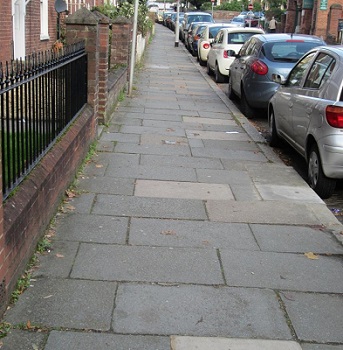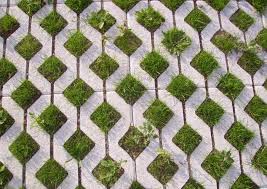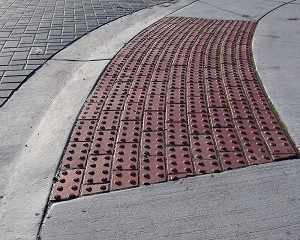Pavement
Contents |
[edit] Introduction
Pavements are a form of exterior surface covering, typically raised and used by pedestrians, running parallel to, and on either side of a road. They provide an area that is separated from, and so protected from vehicular traffic. However, the term can also be used to refer to other paved areas, such as pedestrianised streets, patios, courtyards, driveways, and so on.
Pavements can be constructed using asphalt, concrete, flagstone, cobblestone, artificial stone, bricks, tiles and timber.
The term ‘paver’ or ‘paviour’ (pavior in the USA) refers to a paving stone, tile, brick or piece of concrete used to form a pavement surface. They are usually laid to a fall of 1:60 or more to drain water to one or both sides. They are usually built to a minimum width of 1.2 m where this is possible.
The main British and European Manufacturing Standards relating to paving are:
[edit] Types of pavement
[edit] Flexible paving
This may consist of the following layers:
- 100 mm blinded and consolidated hardcore.
- 40 mm thick base course of coated macadam.
- 20 mm thick wearing course of coated macadam.
[edit] Rigid paving
This may consist of the following layers:
- 75 mm thick consolidated hardcore.
- 75 mm thick plain insitu concrete with contraction and expansion joints.
[edit] Pavers
This may consist of the following layers:
- 75 mm thick consolidated hardcore.
- 25 mm thick dry cement/sand bed.
- 600 x 600 x 50 mm precast concrete pavers laid with butt joints filled with mortar.
[edit] Small unit pavers
This may consist of the following layers:
- 100 mm thick consolidated hardcore.
- 50 mm thick bed of sharp sand.
- 60 mm thick precast concrete plain or interlocking pavers vibrated into bed with sand-filled joints.
[edit] Cobblestones
Cobblestone were frequently used in early pavement construction. They are small stones or pebbles that were traditionally gathered from stream beds and hence had been rounded and smoothed by water. They are usually set in sand or bound together with mortar.
[edit] Setts
Setts are rectangular stones, usually made of granite, often used in landscape architecture as they can be arranged in various decorative ways with different patterns and colours.
The second edition of The Dictionary of Urbanism by Rob Cowan, published in 2020, suggests that a sett is: ‘A small rectangular quarried stone used for paving. Setts are often popularily called cobbles (see cobbled). Wooden and rubber setts have also occasionally been used.'
A Belgian block is: ‘A cubical paving block; a sett’
[edit] Interlocking grids
These are concrete or stone units with open, permeable spaces between them.
[edit] Tactile paving
These come in a variety of forms and are commonly used in urban areas as a means of hazard warning for visually-impaired pedestrians at kerb edges, road crossings and gradient changes. They can also be used on cycle paths as a way of demarcating the area to be used by cyclists.
For more information, see Hazard warning surfaces.
[edit] Green paving
New products are being developed that incorporate technology with to make pavements smarter and greener. For example, see Pavegen.
[edit] Other definitions
The second edition of The Dictionary of Urbanism by Rob Cowan, published in 2020, suggests that pavement can mean:
- '(UK) The raised surface for pedestrians beside a street or road. The US equivalent is sidewalk, though pavement is used in some parts of the southern states.
- (US, and UK highway engineers) The structure of a road, including its surface and underlying foundations. The general UK equivalent is roadway.
- A paved surface.
- An alley.
From the Latin pavire, to beat hard.'
[edit] Related articles on Designing Buildings
- Binder course.
- Bitumen binder may delay road surface deterioration.
- Bituminous mixing and laying plant.
- BREEAM Hard landscaping and boundary protection.
- Britain's historic paving.
- Capping layer.
- Coal holes, pavement lights, kerbs and utilities and wood-block paving.
- Code of Practice for Ironwork Systems Installation and Refurbishment.
- Glossary of paving terms.
- Groundwater control in urban areas.
- Hazard warning surfaces.
- Highway drainage.
- Hoggin.
- How to lay block paving.
- Kerbs.
- Landscape design.
- Overview of the road development process.
- Pavegen.
- Pedestrianised.
- Permeable pavements.
- Pervious pavement.
- Road construction.
- Types of road and street.
- Vicars' close.
- Walkway.
[edit] External references
- ‘Building Construction Handbook’ (6th ed.), CHUDLEY, R., GREENO, R., Butterworth-Heinemann (2007)
Featured articles and news
The UK's Modern Industrial Strategy: A 10 year plan
Previous consultation criticism, current key elements and general support with some persisting reservations.
Building Safety Regulator reforms
New roles, new staff and a new fast track service pave the way for a single construction regulator.
Architectural Technologist CPDs and Communications
CIAT CPD… and how you can do it!
Cooling centres and cool spaces
Managing extreme heat in cities by directing the public to places for heat stress relief and water sources.
Winter gardens: A brief history and warm variations
Extending the season with glass in different forms and terms.
Restoring Great Yarmouth's Winter Gardens
Transforming one of the least sustainable constructions imaginable.
Construction Skills Mission Board launch sector drive
Newly formed government and industry collaboration set strategy for recruiting an additional 100,000 construction workers a year.
New Architects Code comes into effect in September 2025
ARB Architects Code of Conduct and Practice available with ongoing consultation regarding guidance.
Welsh Skills Body (Medr) launches ambitious plan
The new skills body brings together funding and regulation of tertiary education and research for the devolved nation.
Paul Gandy FCIOB announced as next CIOB President
Former Tilbury Douglas CEO takes helm.
UK Infrastructure: A 10 Year Strategy. In brief with reactions
With the National Infrastructure and Service Transformation Authority (NISTA).
Ebenezer Howard: inventor of the garden city. Book review.
The Grenfell Tower fire, eight years on
A time to pause and reflect as Dubai tower block fire reported just before anniversary.
Airtightness Topic Guide BSRIA TG 27/2025
Explaining the basics of airtightness, what it is, why it's important, when it's required and how it's carried out.
Construction contract awards hit lowest point of 2025
Plummeting for second consecutive month, intensifying concerns for housing and infrastructure goals.
Understanding Mental Health in the Built Environment 2025
Examining the state of mental health in construction, shedding light on levels of stress, anxiety and depression.



























